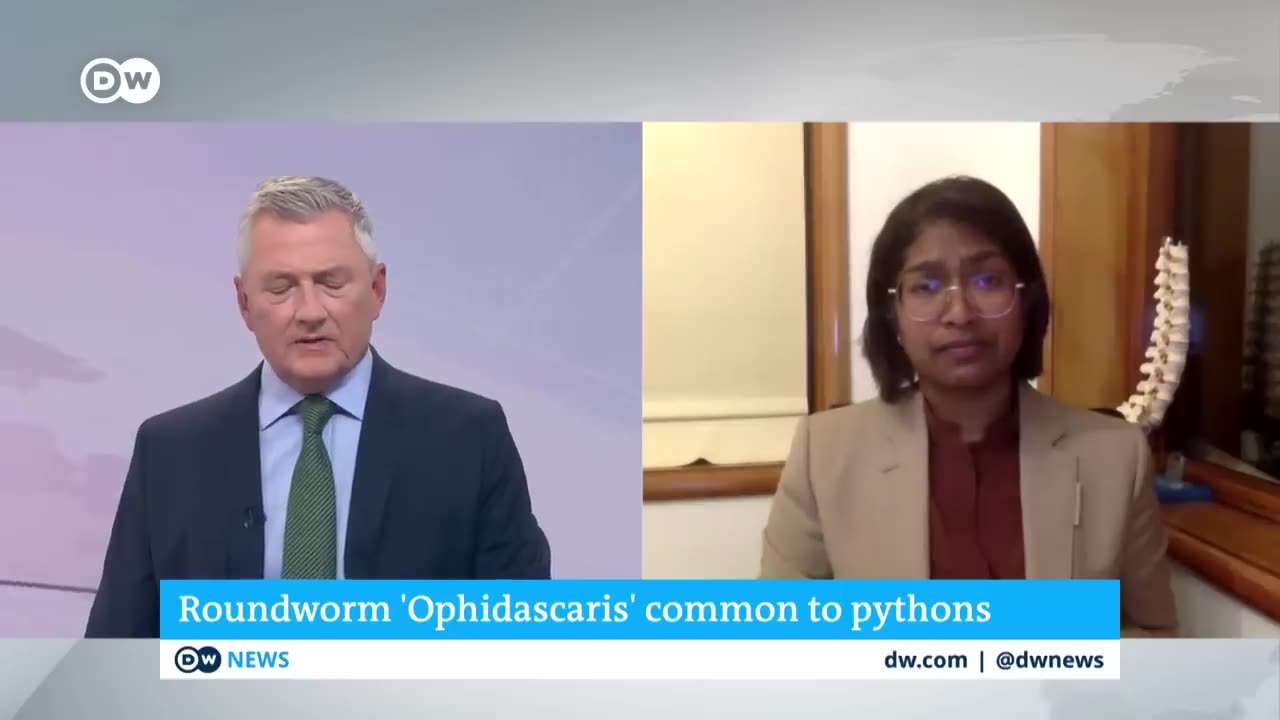Premium Only Content

Neurosurgeon removes live worm from woman's brain in world-first discovery
Scientists this week published information on an unprecedented case in Australia, where they found and extracted a live parasitic worm from the brain of a woman in Canberra. The worm was some 8 centimeters (just over 3 inches) long and is a roundworm most commonly seen in python species, known as Ophidascaris robertsi. It was found in the brain of a 64-year-old woman after she had complained of a variety of changing symptoms and afflictions over a prolonged period.
Neurosurgeon Hari Priya Bandi found and removed the parasite with forceps during a biopsy. "I used tumor-holding forceps and lifted out something that I definitely was not expecting: a linear, squiggling line," Bandi told DW on Tuesday. "And my junior doctor said, 'is that an artery?', because that's what it looked like. And I said, 'it's not an artery, we're nowhere near any artery!' And I noticed it was moving and I went, 'just get it out of my forceps!' So we rapidly put it in a pathology pot, and it was a vigorously wriggling worm."
Asked whether it was fair to assume the worm had been moving around inside, Bandi said it was and that their scans demonstrated as much. The woman's symptoms had started as lung, liver and adominal problems, Bandi said, but evolved towards problems like depression, presumably as the animal's activities kept affecting different parts of the brain. Her pyschiatrist had conducted CT scans in which what was later identified as the worm was first visible, and later pre-operation CT scans had shown how the abnormality had moved.
A known possibility, but an unprecedented find
"When you operate on someone's brain and you take a biopsy or something, you never expect to encounter something living," Doctor Sanjaya Senanayake, who co-authored the study with Bandi, told Reuters. "[It] was certainly something we'll never forget." The paper on the case was published in the Emerging Infectious Diseases journal on Monday. Bandi and Senanayake speculated that the woman might have been exposed to the parasite when foraging for wild grasses to make spinach, when she might have been exposed to python feces. The worm was successfully removed last year. The woman, whom Senanayake praised as being "very courageous and patient," returned to normal life after the operation to remove the parasite, but medical professionals have continued to monitor her. "Obviously, because this was an unusual case at so many levels, we're keeping a close eye on her and keeping in touch," Senanayake said. Senanyake said the discovery came as a surprise, but that they were aware of the possibility, particularly as human and animal habitats continue to overlap more and more. "Other snakes around the world carry this parasite, so it is quite likely that other new cases will be documented," he said. "So hopefully, raising awareness of that will help other healthcare workers around the world."
-

Inverted World Live
3 hours agoMan Sees Creature in Loch Ness | Ep. 116
15.2K3 -
 LIVE
LIVE
PandaSub2000
13 hours agoLIVE 10pm ET | EXORCIST LEGION VR (Horror In VR!)
95 watching -
 LIVE
LIVE
SmashJT
54 minutes agoCollective Shout Keeps “HARRASSING” Me | Smashcast
91 watching -
 LIVE
LIVE
StevieTLIVE
1 hour agoWarzone Wins ALL Night w/ GloryJean
66 watching -
 LIVE
LIVE
Laura Loomer
5 hours agoEP146: Loomer EXPOSES Big Tech's Complicity With Anti-ICE Violence
683 watching -
 31:39
31:39
Standpoint with Gabe Groisman
1 day ago“Most People Have NO IDEA What Isolationism could do to America” Rep Rich McCormick Joins Standpoint
1.83K2 -
 LIVE
LIVE
MissesMaam
4 hours ago75% DONE WITH PERFECTION!!! | Stardew Co-Op 💚✨
97 watching -
 LIVE
LIVE
Clenzd Gaming
2 hours agoThe Return
61 watching -
 DVR
DVR
DeafWarriorLegendary
1 hour ago🔥Deaf Streamer🔥
248 -
 2:04:52
2:04:52
TimcastIRL
4 hours agoBomb Threat At TPUSA, Bomb Squad Deployed For Controlled Detonation | Timcast IRL
181K182